Starting a running journey after 50 might sound ambitious or slightly unhinged, but trust us, it can be one of the most rewarding ways to boost your health, energy, and ability to climb stairs without groaning. But let’s be real: as we age, our bodies change. Knees get opinionated, and arches get dramatic.
Whether you’re cautiously jogging around the block, power-walking the park, or mastering the treadmill in style, the right running shoes can make all the difference. Comfort, support, and a proper fit aren’t just nice to have; they’re non-negotiable. In this guide, we’ll walk (or jog!) you through the best running shoes for beginners over 50, focusing on models that cushion cranky joints, stabilize wobbly ankles, and cater to foot quirks like bunions, flat feet, or high arches because your feet deserve VIP treatment too.
Let’s find you the perfect pair that says, “I’m here to run, not suffer,” and make your new running adventure safe, enjoyable, and actually something you’ll want to keep doing for years to come.
Contents
- Understanding the Importance of the Right Running Shoes
- Key Features to Look for in Running Shoes
- Top Running Shoe Brands for Beginners Over 50
- The Best Running Shoes for Beginners Over 50
- How to Choose the Right Running Shoes
- Tips for Breaking in New Running Shoes
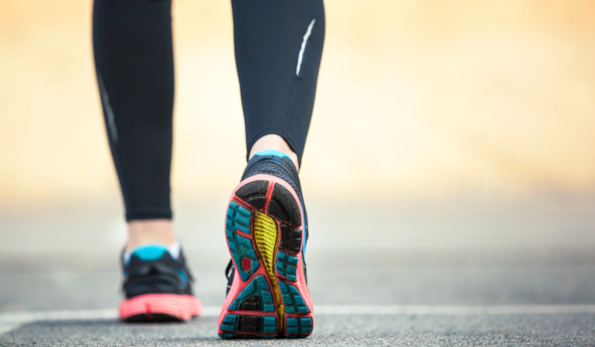
Understanding the Importance of the Right Running Shoes
Impact of Age on Running
As we age, our bodies start sending little reminders, like creaky knees and mystery aches that we’re not 25 anymore (and haven’t been for a while). But don’t hang up your running shoes just yet! Aging doesn’t mean your running days are over; it just means it’s time to train smarter, recover like a pro, and maybe stretch a little more than you brag about. With the right approach, you can keep logging miles and feeling fabulous, just with a bit more warm-up and a lot less ego.
1. Decreased Muscle Mass and Strength
Sarcopenia sounds like a fancy pasta, but it’s actually the sneaky muscle thief that starts creeping in around age 30 and really picks up the pace after 50. Translation? Your muscles may RSVP “no” to things they used to do without complaint, like powering up hills or staying stable on uneven ground. But don’t worry! You can fight back. Adding some strength training to your routine is like giving your muscles a pep talk, and possibly a protein shake. It keeps you strong, steady, and ready to outrun Father Time (or at least jog past him with confidence).
2. Reduced Joint Flexibility and Mobility
As we age, our joints can get a little… cranky. Thanks to less synovial fluid (a.k.a. nature’s joint lube) and some well-earned cartilage wear, things might start feeling more tin man than marathon man. The result? Shorter strides, funky gait patterns, and a higher chance of pulling something besides a muscle. But don’t panic; help is here! Regular stretching, mobility work, and low-impact cross-training (like swimming, cycling, or pretending to enjoy yoga) can keep those joints moving smoothly and sass-free. Think of it as joint maintenance—WD-40 for your knees, minus the fumes.
3. Slower Recovery Time
Older runners need a bit more TLC between runs, not because they’re lazy, but because their bodies are taking a little longer to stitch things back together. Blame it on slower collagen production and cellular repair that now runs on island time. That’s why recovery tools like good food, plenty of water, solid sleep, and guilt-free rest days become essential. Think of it this way: recovery isn’t slacking; it’s advanced-level training… with snacks and naps included.
4. Changes in Cardiovascular Efficiency
Maximum heart rate and VO₂ max naturally decline with age, impacting aerobic performance. Although this limits peak performance, consistent aerobic exercise like running helps maintain heart health, improve stamina, and reduce the risk of cardiovascular disease.
5. Increased Risk of Overuse Injuries
As we age, our tendons and ligaments start acting like grumpy rubber bands; less stretchy and way slower to bounce back. This means older runners are more likely to collect overuse injuries like plantar fasciitis, Achilles tendinitis, or stress fractures basically the “greatest hits” of things you don’t want. But with proper footwear (the kind that hugs your arches like a supportive friend), mixing up your training surfaces (grass, track, treadmill—variety is your joint’s BFF), and increasing mileage like you’re sneaking in extra dessert, slow and steady, you can outsmart these aches and keep cruising comfortably.
Benefits of Running for Individuals Over 50
Running after 50 comes with a long list of benefits—stronger heart, sharper mind, better mood, and the joy of smugly outpacing people half your age on the sidewalk. Sure, it requires a little more prep (and maybe a few more warm-up groans), but the payoff is huge. With the right care and a dash of patience, running can keep you feeling energized, empowered, and slightly superior to your former couch-loving self. It’s basically the fountain of youth, with more sweat and fewer tourists.
1. Improved Cardiovascular Health
Running is like a workout for your heart, with zero gym memberships and a lot more sweat. It boosts circulation, lowers blood pressure, kicks bad cholesterol (LDL) to the curb, and rolls out the red carpet for good cholesterol (HDL). For anyone over 50, lacing up those shoes regularly is like sending your heart a love letter, complete with lower risks of heart disease, stroke, and all those other “fun” conditions doctors like to warn us about. Basically, every run is a little cardio insurance… minus the paperwork and copay.
2. Enhanced Bone Density and Joint Strength
Contrary to popular belief (and what your joints might say in the morning), moderate-impact activities like running don’t wreck your bones; they actually help build them. As we age and things like osteopenia and osteoporosis try to sneak in uninvited, running shows up like a bouncer for your skeleton. It stimulates bone remodeling, basically giving your bones a gentle wake-up call, and strengthens the muscles and ligaments around your joints. Of course, this only works if you’ve got decent form and shoes. So yes, running can help keep your bones strong, and that’s not just a calcium commercial talking.
3. Weight Management and Metabolic Health
Ah, aging—the magical time when your metabolism slows down and your body starts treating calories like precious keepsakes. But don’t worry; running comes to the rescue! It torches calories, boosts insulin sensitivity, and gives your metabolism the pep talk it desperately needs. Not only does it help you manage weight without swearing at your bathroom scale, but it also lowers your risk of type 2 diabetes. So, in short: running helps you outpace the snack-related consequences of midlife… one sweaty, glorious step at a time.
4. Better Mental Health and Cognitive Function
Running is like free therapy, minus the couch and plus a little sweat. It kicks your brain into happy gear by releasing endorphins and serotonin, those magical mood-boosting chemicals that say, “You’ve got this!” even when your legs are questioning your life choices. Not only does it help chase off anxiety, stress, and the occasional existential crisis, but it also boosts brainpower by increasing blood flow and encouraging new neural connections. In other words, running helps you feel better and think sharper, like a mood ring for your brain, but way more effective.
5. Improved Sleep Quality
Let’s face it—after 50, sleep can start playing hard to get. You toss, you turn, you wonder why your pillow hates you. The good news? Running might just be your new bedtime buddy. Regular aerobic exercise has been shown to improve sleep quality and duration, so you can spend less time staring at the ceiling and more time actually dreaming (maybe even about finishing a 5K). Bonus: better sleep means you’re more alert during the day, so you’ll finally remember where you put your keys… or at least what day it is.
6. Boosted Immune System and Longevity
Running does more than just make you feel like a superhero; it actually boosts your immune system like one, too. It gets your white blood cells moving, ready to karate-chop incoming germs, and helps your body fight off infections like a pro. Bonus? People who stay active tend to live longer and dodge more chronic illnesses, so basically, running might not make you immortal, but it gives you a solid head start. Think of it as your body’s way of saying, “Thanks for the jog; here’s a little extra time on the clock.”
7. Enhanced Mobility and Independence
Running isn’t just for chasing buses or escaping awkward conversations; it’s actually a secret weapon for anyone over 50 who wants to keep moving like they still remember the ’80s. By building strength, balance, and coordination, running helps you stay functionally fit, which is a fancy way of saying you’ll still be able to carry groceries, climb stairs, and dance at weddings without pulling something. Independence never looked so sweaty and stylish in compression socks.
8. Social Connection and Community
Many older adults rediscover their social mojo through running groups, local clubs, or signing up for races where the only real competition is who brought the best post-run snacks. These running buddies provide more than just company; it’s like high school, but with better shoes and fewer teenage hormones.
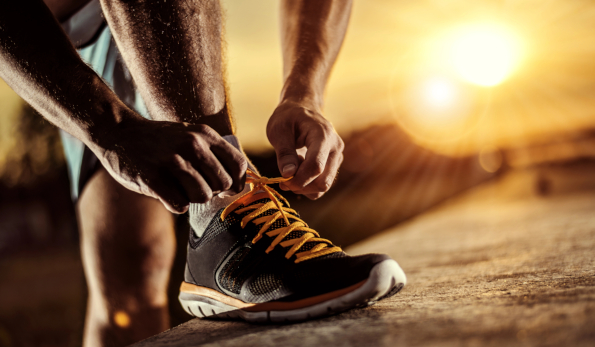
Key Features to Look for in Running Shoes for Beginners Over 50
When choosing the best running shoes for beginners over 50, think of it like dating, but for your feet. You’re not looking for flashy and complicated; you want comfort, support, and zero drama (aka injuries). The goal is to find a sole-mate that cushions your every step, keeps you steady, and doesn’t ghost you after one run.
Here are the key features to look for:
1. Cushioning for Joint Protection
Why it matters: Aging joints, especially knees and hips, need extra shock absorption.
Look for: Shoes with plush midsoles (e.g., EVA foam, gel, or proprietary technologies like Hoka’s Meta-Rocker or Brooks’ DNA Loft).
2. Arch Support
Why it matters: Proper arch support helps with stability, especially for those with flat feet or high arches.
Look for: Neutral support for normal arches, and stability shoes for overpronation (foot rolls inward).
3. Wide Toe Box
Why it matters: Feet tend to widen with age and can develop bunions or other issues.
Look for: Shoes with roomy toe boxes to prevent rubbing and improve balance.
4. Lightweight Design
Why it matters: Lighter shoes reduce fatigue and make running feel easier.
Look for: Shoes that weigh under 10 oz (men) or 8 oz (women), without sacrificing cushioning.
5. Low Heel-to-Toe Drop (Optional)
Why it matters: A moderate heel-to-toe drop (6–10 mm) helps with forward propulsion while maintaining natural foot movement.
Note: Avoid zero-drop shoes unless you have good calf/ankle strength or are used to them.
6. Stability and Grip
Why it matters: Balance can decrease with age, so traction and side-to-side stability help reduce fall risk.
Look for: Durable rubber outsoles with good grip and slight lateral reinforcement.
7. Breathable and Soft Uppers
Why it matters: Prevents blisters and overheating, and keeps feet comfortable over longer walks or jogs.
Look for: Engineered mesh or knit uppers with padded collars and tongues.
8. Easy On/Off Design
Why it matters: Dexterity can decrease with age, making laces harder to manage.
Look for: Slip-on designs, pull tabs, or shoes with quick-lace or toggle systems.
9. Orthotic Compatibility
Why it matters: Many over-50 runners use custom orthotics or insoles.
Look for: Removable insoles and enough interior volume to accommodate inserts.
10. Reputation for Durability
Why it matters: Good shoes are an investment, and durability ensures value over time.
Look for: Reviews highlighting wear resistance and consistent performance over 300–500 miles.
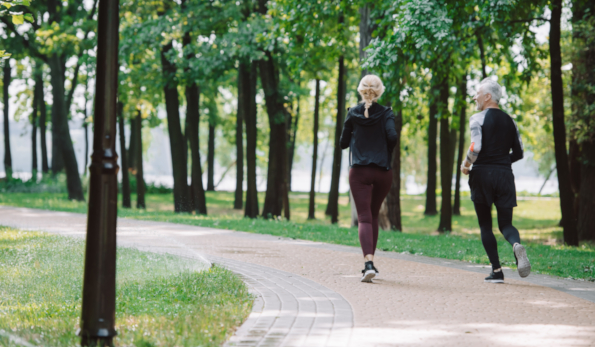
Top Running Shoe Brands for Beginners Over 50
Nike
Nike, Inc. is a leading global sportswear and athletic footwear brand known for its innovative products and marketing strategies. Founded in 1964 as Blue Ribbon Sports and rebranded as Nike in 1971, the company is headquartered in Beaverton, Oregon. Nike’s mission is to bring inspiration and innovation to every athlete in the world, with the iconic slogan “Just Do It.”
The brand is recognized for its high-quality footwear, apparel, and equipment across various sports, including running, basketball, soccer, and training. Nike is also known for its endorsements with high-profile athletes and its commitment to sustainability and social responsibility. The company operates through several subsidiaries, including Jordan Brand and Converse, and has a significant presence in both physical retail and e-commerce.
Mizuno
Mizuno is a Japanese sports equipment and apparel brand founded in 1906, known for its dedication to quality and performance. The company specializes in a wide range of sports, including running, golf, baseball, and volleyball, offering footwear, clothing, and gear designed for athletes of all levels.
Mizuno emphasizes innovation and technology in product development, utilizing advanced materials and design techniques to enhance athletic performance. The brand is recognized globally for its commitment to craftsmanship and has a strong following among professional athletes and sports enthusiasts.
Saucony
Saucony is an American athletic footwear brand established in 1898, known for its running shoes and apparel. The brand focuses on performance, comfort, and innovation, catering to runners of all levels. Saucony incorporates advanced technologies in its products, such as lightweight materials and cushioning systems, to enhance the running experience.
The brand is recognized for its commitment to quality, creating shoes that provide support and durability while maintaining a stylish aesthetic. Saucony actively engages with the running community, promoting events and initiatives that encourage fitness and a healthy lifestyle.
Hoka
Hoka is a footwear brand renowned for its innovative running shoes that prioritize comfort, cushioning, and performance. Founded in 2009 by Jean-Luc Diard and Nicolas Mermoud, Hoka gained popularity for its distinctive oversized midsole design, which enhances shock absorption and stability.
The brand caters to various athletes, including runners, hikers, and casual wearers, and offers a wide range of models suitable for different terrains and distances. Hoka emphasizes a commitment to quality, sustainability, and community engagement, making it a favorite among fitness enthusiasts and professionals alike.
ASICS
ASICS is a Japanese multinational corporation that specializes in athletic equipment and footwear. Founded in 1949 by Kihachiro Onitsuka, the brand originally focused on manufacturing basketball shoes. ASICS has since evolved into a leading global brand known for its high-performance running shoes, apparel, and accessories designed for various sports.
The name ASICS is an acronym for the Latin phrase Anima Sana In Corpore Sano, which translates to A Sound Mind in a Sound Body. The brand emphasizes innovation, technology, and comfort, incorporating advanced features such as Gel cushioning systems and FlyteFoam technology in its products. ASICS is also committed to promoting health and fitness through various community initiatives and partnerships with athletes.
On
On is a Swiss performance running shoe brand known for its innovative technology and design. Founded in 2010, On focuses on creating lightweight, cushioned footwear that enhances running performance. The brand emphasizes a unique CloudTec sole that provides a soft landing and explosive takeoff.
On has gained popularity among both professional athletes and casual runners, promoting a blend of style and functionality. The company’s commitment to sustainability is reflected in its use of eco-friendly materials and manufacturing practices. On’s product line includes running shoes, apparel, and accessories tailored for various running experiences.
The Best Running Shoes for Beginners Over 50
Here’s a list of the best running shoes for beginners over 50 (in no particular order):
Nike Pegasus Plus
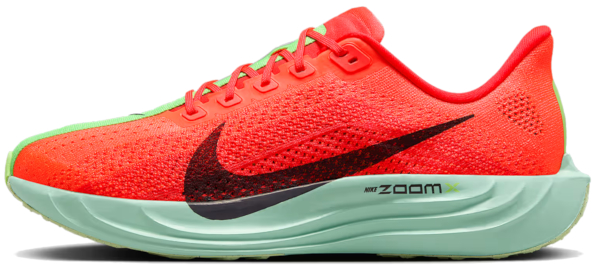
Technical details:
- Support: Neutral
- Best for everyday run
- Superior ZoomX cushioning (feels softer than the Peg 41)
- Medium toe box
- 34 mm stack height
- 10 mm drop for women and 9.5 mm drop for men
- Weight: 7.2 oz for women and 8.6 oz for men
The Nike Pegasus Plus is an excellent choice for beginners over 50, thanks to its blend of comfort, versatility, and durability, qualities that make it especially suited for older runners easing into a new fitness routine. Building on the legacy of Nike’s popular Pegasus line, the Pegasus Plus adds enhanced cushioning and support features that cater to the unique needs of aging feet and joints.
Responsive Yet Cushioned Ride
The Pegasus Plus features Nike’s React foam technology, which offers a smooth, responsive feel while absorbing impact. This combination is especially valuable for runners over 50, as it helps reduce stress on the knees, ankles, and hips, areas more prone to discomfort or injury with age.
Supportive Fit for a Wide Range of Foot Types
With its engineered mesh upper and padded heel collar, the Pegasus Plus provides a secure, adaptive fit that conforms to different foot shapes. This is ideal for older beginners who may experience changes in foot structure, such as lowered arches or wider forefeet. The shoe supports natural movement without feeling restrictive.
Lightweight and Breathable Construction
Despite its cushioned build, the Pegasus Plus remains lightweight and well-ventilated, helping to keep feet cool and reduce fatigue during walks or runs. This makes it a comfortable option for extended wear, whether you’re doing light jogging, walking, or mixing in cross-training.
Reliable Traction and Stability
The outsole is designed with a durable rubber pattern that delivers solid grip and traction across various surfaces. For older runners who may be concerned about balance or stability, this added traction enhances confidence and safety during runs, especially on uneven or wet pavement.
Versatility for Everyday Use
The Pegasus Plus isn’t just a running shoe; it’s also a great all-around trainer for walking, gym workouts, or casual wear. This level of versatility makes it especially valuable for older beginners looking for a single shoe that can keep up with multiple types of activity.
SHOP AT NIKENike Alphafly 3
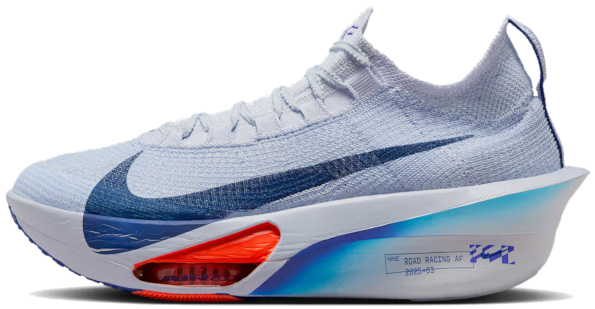
Technical details:
- Support: Neutral
- Best for road racing
- Excellent cushioning
- Spacious toe box
- 40 mm stack height
- 8 mm drop
- Weight: 6.1 oz for women and 7.7 oz for men
The Nike Alphafly 3 may be known as a world-class racing shoe, but it also offers unique benefits that make it a surprising yet smart choice for certain beginners over 50, especially those who are serious about performance, want top-tier joint protection, or are looking for a shoe that makes running feel easier and more efficient.
Exceptional Shock Absorption for Joint Relief
One of the Alphafly 3’s biggest advantages is its thick ZoomX midsole foam combined with Zoom Air pods in the forefoot. This setup delivers unparalleled shock absorption, which is highly beneficial for runners over 50 who want to protect their knees, hips, and ankles from repetitive impact. The soft yet bouncy cushioning provides a cloud-like feel that reduces fatigue and discomfort during longer efforts.
Energy Return That Makes Running Easier
The carbon fiber Flyplate embedded in the midsole gives the Alphafly 3 its famous “propulsive” sensation. For older beginners who may struggle with stamina or efficiency, this added energy return helps reduce the effort needed with each stride. It’s like having a little assistance built into every step, perfect for easing into running or rebuilding lost speed.
Lightweight and Responsive Design
Despite its maximalist build, the Alphafly 3 remains surprisingly lightweight. This reduces the burden on leg muscles and can help prevent early fatigue, especially during longer runs or walks. Beginners over 50 will appreciate how the shoe feels fast without being harsh or demanding.
Rocker Geometry for Smooth Transitions
The shoe’s geometry promotes a smooth heel-to-toe transition, encouraging proper form and making running feel more natural. This can be particularly helpful for older runners working on efficient movement patterns and minimizing stress on their lower limbs.
Premium Fit and Breathability
With its Atomknit 2.0 upper, the Alphafly 3 hugs the foot securely while offering ample breathability. The lockdown feel helps prevent slippage and blisters, while the breathable fabric keeps feet cool, ideal for extended sessions or warm-weather runs.
SHOP AT NIKEASICS Novablast 5
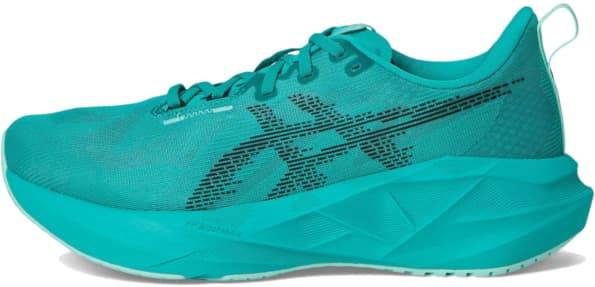
Technical details:
- Support: Neutral
- Best for everyday run
- Excellent cushioning and versatility
- Spacious toe box
- 41.5 mm stack height
- 8 mm drop
- Weight: 7.9 oz for women and 9 oz for men
The ASICS Novablast 5 is a top-tier choice for beginners over 50 who are seeking a cushioned, energetic ride without sacrificing stability or comfort. With its modern design and advanced midsole technology, the Novablast 5 delivers a smooth, supportive experience that makes it easier for older runners to ease into their routine and enjoy every step.
Superior Cushioning with FF BLAST MAX Foam
The Novablast 5 features ASICS’ updated FF BLAST MAX cushioning, which is lighter and more responsive than previous versions. This ultra-plush midsole helps absorb impact and soften landings, critical for protecting aging joints like knees, hips, and ankles. The bounce-back effect also adds a lively feel to every stride, encouraging consistent movement.
Stable Platform for Confident Strides
While the Novablast line is known for its energetic ride, the fifth iteration offers increased sole width and an updated heel bevel, both of which improve stability. This is especially important for beginners over 50, as it helps maintain balance and reduces the risk of rolling an ankle or overpronating.
Lightweight Feel for Reduced Fatigue
Despite its high cushioning, the Novablast 5 is remarkably lightweight. This reduces strain on the legs and feet during longer walks or runs, making it easier for older adults to build endurance gradually without feeling weighed down by their footwear.
Breathable and Adaptive Fit
The engineered mesh upper of the Novablast 5 provides a breathable, sock-like fit that adapts to different foot shapes. This helps reduce pressure points, prevent blisters, and accommodate foot changes that often come with age, such as bunions or swelling.
Versatile for Multiple Activities
From light jogging and brisk walking to cross-training or all-day wear, the Novablast 5 performs well across various scenarios. This versatility makes it a great investment for beginners over 50 looking for one reliable shoe that supports an active lifestyle.
SHOP AT ZAPPOSASICS Superblast 2
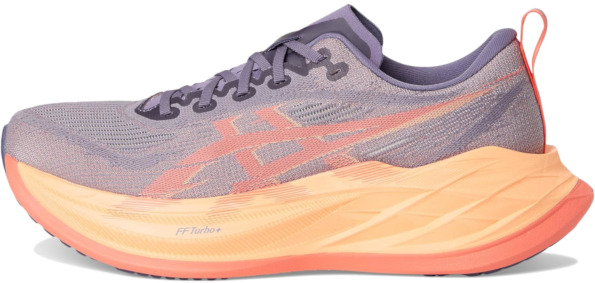
Technical details:
- Support: Neutral
- Best for everyday run
- Impressive cushioning
- Medium toe box
- 42.8 mm stack height
- 8 mm drop
- Weight: 8.8 oz
The ASICS Superblast 2 stands out as an exceptional choice for beginners over 50 thanks to its unmatched combination of cushioning, stability, and lightweight design. As we age, our joints become more sensitive to impact, and the Superblast 2 addresses this concern with its towering stack height, over 40 mm of FF Blast+ ECO and FF Turbo foam. This provides a soft, forgiving platform that helps absorb shock and reduce stress on the knees, hips, and lower back.
What makes it even more ideal for older beginners is the shoe’s surprising lightness for such a maximalist build. Despite its thick midsole, it feels nimble and easy on the feet, reducing fatigue during walks, light jogs, or run-walk intervals. The wide base also adds a sense of stability, which is particularly beneficial for those with balance concerns or those re-entering fitness after a long break.
Additionally, the breathable upper and premium step-in comfort ensure that the shoe feels secure without being restrictive. With its responsive ride and all-day comfort, the ASICS Superblast 2 empowers runners over 50 to train confidently, comfortably, and safely, making it a smart long-term investment for fitness and joint health.
SHOP AT ZAPPOSHoka Clifton 10
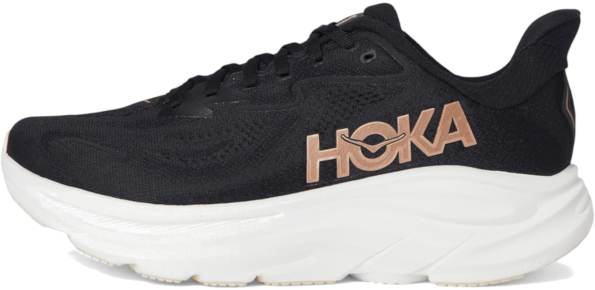
Technical details:
- Support: Neutral
- Best for everyday run, walk
- Well-cushioned, impressive impact protection
- Spacious toe box
- 42 mm stack height
- 8 mm drop
- Weight: 8.80 oz for women and 9.8 oz for men
The Hoka Clifton 10 stands out as an exceptional choice for new runners over 50 thanks to its perfect balance of cushioning, comfort, and support—all essential features for aging feet and joints. Designed with Hoka’s signature technology and thoughtful construction, the Clifton 10 makes running more accessible, enjoyable, and sustainable for older adults just starting or returning to a running routine.
Plush, Balanced Cushioning
The Clifton 10 features Hoka’s renowned EVA midsole, which delivers soft, responsive cushioning without feeling overly bulky. This plush underfoot feel helps reduce the impact on aging knees, hips, and ankles, common areas of concern for runners over 50, while still providing enough responsiveness to encourage proper running form.
Lightweight Design for Easier Strides
Despite its generous cushioning, the Clifton 10 is remarkably lightweight. This helps reduce fatigue during runs and supports a natural, fluid stride, especially important for beginners who are building endurance and strength. The shoe’s featherlight build allows older runners to move confidently without being weighed down.
Rocker Geometry for Smooth Transitions
Hoka’s early-stage Meta-Rocker technology in the Clifton 10 promotes a smooth heel-to-toe transition, making each step feel more effortless. This helps beginners maintain a consistent rhythm and reduces strain on the lower legs, which can be particularly helpful for runners dealing with stiffness or limited mobility.
Breathable Upper with Secure Fit
The Clifton 10 features an engineered mesh upper that enhances breathability and keeps feet cool. Its structured heel and snug midfoot design offer a secure fit, which helps prevent slipping or instability, two concerns that can increase the risk of falls or missteps for older runners.
Reliable Outsole for Everyday Use
The outsole provides dependable grip and durability, making the Clifton 10 suitable for a variety of surfaces, whether it’s a treadmill, track, or paved road. For beginners over 50, having a versatile, go-to shoe that performs well in everyday conditions builds confidence and reduces the need for multiple specialized pairs.
SHOP AT ZAPPOSSaucony Ride 18
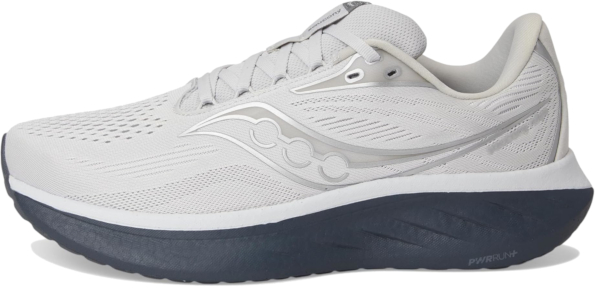
Technical details:
- Support: Neutral
- Best for everyday run
- Nicely cushioned even under the forefoot
- Medium toe box
- 35 mm stack height
- 8 mm drop
- 8.0 oz for women and 9.1 oz for men
The Saucony Ride 18 is a standout choice for beginners over 50 who are looking for a dependable, all-around running shoe that blends comfort, stability, and everyday versatility. As part of Saucony’s neutral running shoe lineup, the Ride 18 builds on the success of previous models with refined updates that cater to the needs of older runners starting or resuming their fitness journey.
Smooth and Balanced Cushioning
The Ride 18 features PWRRUN+ cushioning that offers a perfect blend of softness and responsiveness. This balanced underfoot feel helps absorb impact, crucial for protecting aging joints, while still providing enough energy return to encourage forward motion. It’s ideal for beginners who want a comfortable ride that supports gradual progress without feeling too soft or unstable.
Secure Fit with a Refined Upper
Saucony redesigned the Ride 18’s upper with an engineered mesh that enhances breathability, flexibility, and structure. The secure heel lock and adaptive midfoot design help older runners feel confident with every step, reducing the risk of slips or discomfort during longer walks or runs.
Versatile and Everyday-Friendly
Whether you’re logging miles on the road, walking in the park, or doing a light treadmill session, the Ride 18 adapts well to various surfaces and paces. Its versatile build makes it a practical daily trainer, especially for runners over 50 who value simplicity and consistency in their gear.
Lightweight Yet Supportive
Despite its cushioned feel, the Ride 18 remains relatively lightweight, which helps reduce fatigue during activity. The shoe supports natural foot movement without feeling restrictive, a key benefit for aging feet that may be more sensitive or prone to stiffness.
Reliable Traction and Durability
With a rubber outsole designed for everyday mileage, the Ride 18 provides excellent grip and longevity. This ensures older runners can count on dependable footing and extended use without worrying about premature wear and tear.
SHOP AT ZAPPOSSaucony Tempus 2
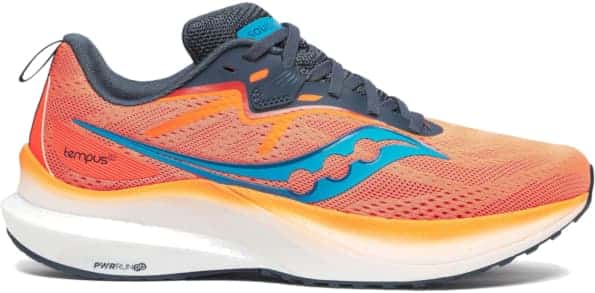
Technical details:
- Support: Stability
- Best for speed run/daily run
- Excellent cushioning
- Medium toe box
- 33 mm stack height
- 8 mm drop
- 8.2 oz for women and 9.4 oz for men
The Saucony Tempus 2 is an ideal running shoe for beginners over 50 who need both structured support and responsive cushioning. Blending the benefits of a stability shoe with the energetic ride of a performance trainer, the Tempus 2 is specifically designed to help runners feel supported, protected, and comfortable, making it a strong choice for older adults easing into or returning to a running routine.
Exceptional Stability for Overpronators
Many runners over 50 experience changes in gait mechanics, including overpronation (when the foot rolls inward excessively). The Tempus 2 addresses this with a unique guidance system that combines a supportive PWRRUN Frame with a plush PWRRUN PB core, offering gentle, adaptive stability without feeling rigid. This keeps the foot aligned and helps reduce strain on knees, hips, and ankles.
Energized Cushioning with Soft Landings
Unlike traditional stability shoes that may feel dense or stiff, the Tempus 2 features Saucony’s premium PWRRUN PB foam, known for its lightweight responsiveness and bounce. It delivers a springy, energized ride while still providing soft landings, making every step easier on aging joints and muscles.
Lightweight, Streamlined Feel
Despite its stability-focused design, the Tempus 2 is surprisingly lightweight. This helps reduce fatigue, especially for beginners building endurance or those who may be transitioning from walking to running. Its sleek build makes the shoe feel nimble yet secure, ideal for runners over 50 seeking both comfort and performance.
Breathable Upper with Personalized Fit
The engineered mesh upper is breathable and supportive, featuring a well-structured heel and midfoot for a locked-in fit. This helps prevent foot slippage, enhances control, and reduces the risk of blisters, all important considerations for aging feet that may be more sensitive to pressure points.
Durable Outsole for Long-Term Use
The Tempus 2 is built to last, with strategically placed rubber on the outsole that provides excellent traction and durability. It performs reliably on roads, tracks, and treadmills, making it a dependable choice for daily training.
SHOP AT ZAPPOSSaucony Endorphin Pro 4
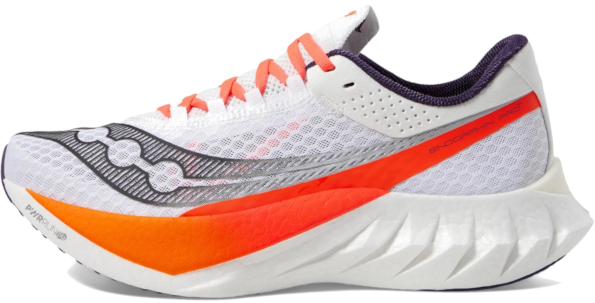
Technical details:
- Support: Neutral
- Best for everyday run/speed training
- Excellent, long-lasting cushioning
- Spacious toe box
- 39.5 mm stack height
- 8 mm drop
- Weight: 6.5 oz for women and 7.5 oz for men
The Saucony Endorphin Pro 4 may be built for speed, but its combination of advanced cushioning, smooth transitions, and lightweight support makes it an excellent choice for performance-minded beginners over 50. If you’re just starting your running journey later in life and want a shoe that reduces impact while helping you move more efficiently, the Endorphin Pro 4 delivers elite-level benefits tailored to your needs.
Soft Yet Responsive Cushioning for Joint Protection
At the core of the Endorphin Pro 4 is Saucony’s dual-foam system: PWRRUN HG on top for soft landings and PWRRUN PB below for responsive energy return. This setup absorbs impact exceptionally well, protecting aging joints, like knees, hips, and ankles, while still delivering the pep needed to keep your stride light and easy.
Carbon Plate for Smoother, More Efficient Strides
A full-length carbon fiber plate embedded in the midsole works with Saucony’s SPEEDROLL technology to guide the foot forward with less effort. For older beginners who may struggle with endurance or form, this propulsion effect reduces muscular fatigue and makes each step feel more fluid, helping extend your runs comfortably.
Lightweight Build Reduces Fatigue
Despite its high cushioning and carbon plate, the Endorphin Pro 4 remains impressively lightweight. This is a major plus for older runners who want to avoid heavy shoes that can tire the legs. Whether you’re running or walking, the lightness helps you move longer and easier.
Secure, Breathable Fit for All-Day Comfort
The upper features a breathable engineered mesh with improved structure around the midfoot and heel. This creates a secure, lockdown fit that prevents foot slippage and hot spots, important for beginners over 50 whose feet may be more sensitive or prone to irritation.
Ideal for Walk-Run Progressions and Long Sessions
The Endorphin Pro 4 isn’t just for racing; it’s also excellent for walk-run intervals, long walks, or light jogs where comfort and performance matter. Its forgiving cushioning and smooth ride make it a great partner for gradually increasing your activity level while minimizing discomfort or injury risk.
SHOP AT ZAPPOSSaucony Guide 18
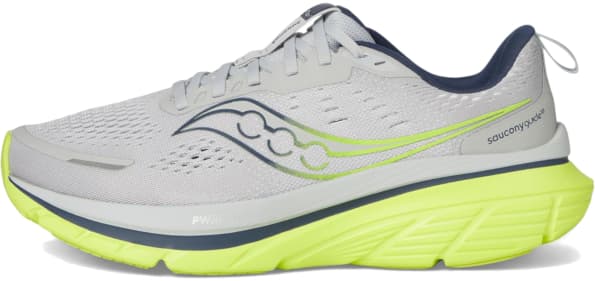
Technical details:
- Support: Stability
- Best for everyday run
- Excellent cushioning
- Spacious toe box
- 35 mm stack height
- 6 mm drop
- Weight: 8.6 oz for women and 9.6 oz for men
The Saucony Guide 18 is an excellent choice for beginner runners over 50 thanks to its thoughtful balance of stability, cushioning, and comfort, key features that address the needs of aging joints, changing gait patterns, and common foot issues.
One of the standout features of the Guide 18 is its medial post and HOLLOW-TECH support system, which offers gentle stability without the stiffness often found in traditional motion control shoes. This is especially beneficial for overpronators or runners who need light guidance to maintain proper alignment during their stride, helping to reduce the risk of knee, hip, and lower back discomfort.
The PWRRUN midsole cushioning delivers a responsive yet soft ride, absorbing impact with every step and easing pressure on joints. For beginners over 50, this translates to a smoother, more forgiving running experience that encourages consistency without fear of pain or overexertion.
Additionally, the Guide 18 offers a generous toe box and a secure yet adaptable fit, making it suitable for a wide range of foot shapes, including those experiencing bunions or mild swelling. Its lightweight design and breathable upper add to its comfort, making it ideal for both shorter runs and longer walks.
SHOP AT ZAPPOSMizuno Neo Zen
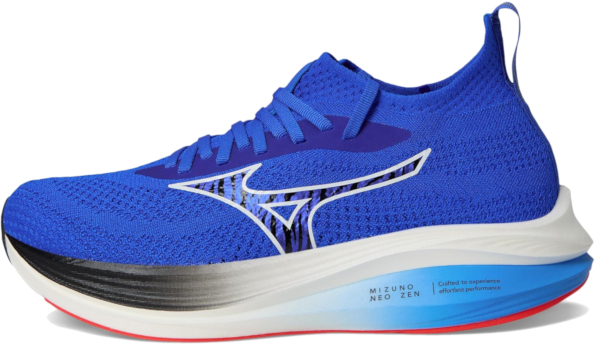
Technical details:
- Support: Neutral
- Best for everyday run
- Remarkable cushioning
- Slightly roomy toe box
- 40 mm stack height
- 6 mm drop
- Weight: 7.1 oz for women and 8.5 oz for men
The Mizuno Neo Zen is a standout option for beginners over 50 who prioritize comfort, simplicity, and joint-friendly design. Engineered with a focus on softness and natural movement, the Neo Zen delivers a smooth, effortless ride that caters to the specific needs of aging bodies just beginning or returning to a running routine.
Exceptional Softness for Joint Protection
At the heart of the Neo Zen is Mizuno’s new SMOOTH STRETCH WAVE midsole, which provides ultra-soft cushioning and superior shock absorption. This is especially beneficial for older runners who may experience joint stiffness or arthritis, as it minimizes the impact on knees, hips, and lower back during every step.
Minimalist Design with Maximum Comfort
The Neo Zen features a slip-on design with a stretchy knit upper that molds comfortably to the shape of the foot. This minimalist, laceless construction eliminates pressure points and makes the shoe easy to put on and take off, perfect for runners over 50 who value simplicity, convenience, and all-day wearability.
Natural Ride for a More Fluid Stride
With a low heel-to-toe drop and flexible sole, the Neo Zen promotes a more natural gait cycle. This encourages better posture and smoother transitions, helping reduce strain on muscles and tendons. It’s an ideal choice for beginners looking to develop healthy, efficient running mechanics right from the start.
Lightweight Feel to Reduce Fatigue
Despite its plushness, the Neo Zen is extremely lightweight, making it easier for older adults to move freely without feeling burdened by heavy footwear. This supports longer walks, light jogs, and daily activity without unnecessary fatigue.
Stylish and Versatile for Everyday Use
The Zen-inspired aesthetic of the Neo Zen makes it more than just a running shoe; it blends easily into casual wardrobes and can be worn comfortably for errands, travel, or leisure. For beginners over 50, this dual-purpose functionality means more use and more value from a single pair.
SHOP AT ZAPPOSOn Cloudsurfer 2
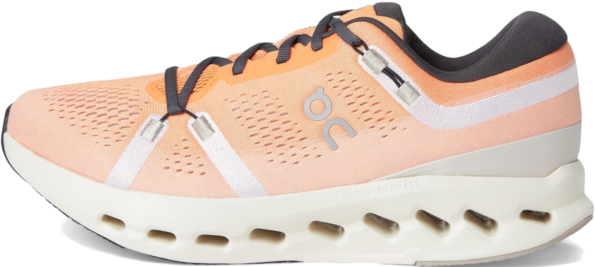
Technical details:
- Support: Neutral
- Best for everyday run
- Excellent cushioning
- Medium toe box
- 37.5 mm stack height
- 9 mm drop
- Weight: 7.9 oz for women and 9.2 oz for men
The On Cloudsurfer 2 is a top-tier choice for beginners over 50 who value comfort, joint-friendly support, and a smooth, natural ride. Known for its innovative CloudTec Phase cushioning and sleek, modern feel, the Cloudsurfer 2 combines cutting-edge design with practical benefits tailored to the needs of older adults starting or resuming a running routine.
Exceptionally Soft Landings with CloudTec Phase
At the heart of the Cloudsurfer 2 is On’s newest midsole innovation: CloudTec Phase. Unlike traditional pods, this phase-based cushioning collapses sequentially, creating a smooth, rolling motion with every step. For runners over 50, this means less impact on the joints and more shock absorption, especially important for reducing stress on aging knees, hips, and ankles.
Lightweight and Easy on the Legs
The Cloudsurfer 2 is surprisingly lightweight, making it ideal for beginners who are easing into running and don’t want a shoe that feels bulky or fatiguing. The feather-light build helps maintain energy during walks, jogs, or run-walk intervals, and supports natural movement throughout your stride.
Smooth Transitions for a More Natural Gait
With its rocker-inspired geometry and full-length cushioning, the Cloudsurfer 2 promotes smooth heel-to-toe transitions. This encourages better posture and running mechanics, helping beginners over 50 build healthy habits that protect their bodies over time.
Comfortable, Adaptive Fit
The engineered mesh upper provides breathability and a gentle, adaptive fit that accommodates foot shape changes that can occur with age (like swelling or bunions). The upper is soft against the skin, while still offering enough structure to keep your foot stable and secure during activity.
Eco-Friendly and Minimalist Design
The Cloudsurfer 2 is not only high-performing but also eco-conscious, featuring dope-dyed yarn and a high percentage of recycled materials. Its clean, minimalist look transitions well from workout to casual wear, ideal for older beginners who value versatility and style alongside function.
SHOP AT ZAPPOSHow to Choose the Right Running Shoes for Beginners Over 50
As a beginner runner over 50, picking the right running shoes is basically self-care for your knees, hips, and dignity. The wrong pair can turn a jog into a hobble and have you Googling “ice pack hacks” by lunchtime. To stay comfy, avoid injuries, and keep moving like a well-oiled machine (or at least a decently maintained one), here’s what to keep in mind:
1. Prioritize Cushioning and Shock Absorption
As we age, our joints get a little less springy and a bit more… opinionated. With cartilage playing hard to get, shock absorption becomes the MVP of your running shoe. Look for shoes with generous midsole cushioning, especially under the heel and forefoot because your knees, hips, and lower back aren’t fans of hard landings anymore. EVA foam, gel pods, and air units aren’t just fancy buzzwords; they’re your new best friends in the fight against post-run groaning and awkward “why am I sore there?” moments.
2. Focus on Arch Support
Feet have a funny way of reinventing themselves with age, kind of like your music taste, but less predictable. One day you’re fine, and the next your arches are either collapsing like a bad souffle or sky-high like they’re auditioning for a tightrope act. That’s why the right arch support is key. Whether you’re team flat foot or high arch drama, the right shoe can save your feet, ankles, and even your cranky lower back from staging a protest. Luckily, many brands make shoes tailored to your arch type because one-size-fits-all went out with disco.
3. Check for a Roomy Toe Box
A wide, rounded toe box is like a luxury suite for your toes, plenty of room to stretch out, relax, and not fight for elbow space (or toe space, in this case). It lets your toes splay naturally, which helps prevent blisters, bunions, and those dreaded “why does my toenail hate me?” moments. Especially if your feet puff up like bread dough during exercise, give those toes the space they deserve. Trust us, cramped toes are grumpy toes.
4. Consider Stability or Motion Control Shoes
If you overpronate, meaning your foot rolls inward like it’s trying to sneak off without the rest of you, a stability or motion control shoe can help keep things in line. Think of it as a traffic cop for your feet, gently guiding your stride so your knees and ankles don’t start filing complaints. These features are especially handy for staying balanced and upright because let’s face it, dramatic tumbles are only funny when they happen in cartoons.
5. Look for Lightweight but Supportive Designs
Back in the day, supportive running shoes felt like you were strapping bricks to your feet, great for leg day, not so much for running. Luckily, modern designs have ditched the clunky dinosaur look. Today’s running shoes manage to be supportive and lightweight, like the yoga instructor of footwear. A lighter shoe means less fatigue, better stride efficiency, and a lower chance of you dramatically collapsing on a park bench mid-run while pretending to tie your shoe.
6. Prioritize Fit and Comfort Over Trends
Don’t let flashy designs or marketing hype fool you, just because a shoe looks fast doesn’t mean it won’t turn your feet into whining divas. Comfort should be your #1 priority, not whether the color matches your water bottle. Pro tip: try on shoes later in the day when your feet are naturally more swollen, kind of like how they’ll be mid-run. And don’t forget to wear the same socks you plan to run in, unless you enjoy surprise blisters and regret.
7. Consult a Specialist if Possible
Think of visiting a running store with gait analysis or chatting with a podiatrist as getting a personal stylist for your feet. They’ll watch you walk, analyze your stride like a detective solving a mystery, and then match you with shoes that actually get you. No more guessing games or buying shoes just because they “look fast.” It’s like Tinder for your feet, only with less ghosting and more arch support.
Tips for Breaking in New Running Shoes
Breaking in new running shoes is like starting a new relationship; take it slow, or you’ll end up with blisters and regret. Even though modern shoes are made to feel great right out of the box (like they’re whispering sweet nothings to your arches), your feet still need time to adjust to the fit, cushioning, and support. Especially if you’re new to running or making a comeback, don’t go from unboxing to marathon overnight unless your idea of fun includes hobbling like a cowboy in a spaghetti western.
1. Wear Them Around the House First
Start by wearing your new running shoes indoors—yes, even if it makes you feel like you’re training for the Olympics while folding laundry. It gives your feet a chance to get acquainted with their new roommates in a low-impact, low-drama environment. Whether you’re pacing the kitchen, chasing the dog, or strutting through the grocery store like it’s a catwalk, a few hours a day can make a big difference before you officially take your shoes on their first real adventure.
2. Start with Short Runs
Resist the urge to treat your new shoes like a sports car you just drove off the lot; no long runs right out of the box. Start with short, easy jogs (think 10–20 minutes, not a Forrest Gump situation) to see how the shoes behave. Give it a week or two to build up distance, while keeping an eye out for any discomfort or weird pressure points. If your shoes start pinching, rubbing, or making your toes feel like they’re auditioning for a horror film, it’s time to pump the brakes.
3. Rotate with Your Old Shoes
If you’re retiring your old, battle-worn sneakers, don’t ghost them just yet. Ease into the relationship with your new kicks by alternating between the two. This gentle transition gives your body time to adjust to the fresh cushioning and updated support, without shocking your knees into filing a complaint. Plus, your old shoes will appreciate one last victory lap before heading to shoe Valhalla.
4. Check for Proper Fit
Sometimes that “breaking in” pain is just your feet screaming, “These don’t fit!”, not something a few walks around the block will fix. Make sure there’s about a thumb’s width of wiggle room in the toe box, your heel isn’t doing the cha-cha, and your arches feel like they’re getting a gentle hug, not a passive-aggressive squeeze. If anything feels off, don’t try to force it; this isn’t Cinderella’s slipper. Return them early and save yourself (and your toes) the drama.
5. Use the Right Socks
Don’t sabotage your fancy new running shoes with those sad, worn-out socks from the laundry’s dark side. Slip on the same type of socks you’ll actually run in, preferably the moisture-wicking, cushioned kind that whisper sweet nothings to your feet. The right socks can boost comfort, cut down on friction, and keep your toes from staging a rebellion while you break in your shoes. Because nothing ruins a good run like realizing your socks are the real villains.
6. Be Patient and Listen to Your Body
Some shoes will feel “just right” right out of the box, like a magical foot hug. Others? Not so much. They might need a little more time to charm your feet into liking them. Don’t rush the relationship; let your feet and joints be the judge (they’re brutally honest anyway). If you start feeling persistent pain, hot spots, or blisters, that’s your body’s way of saying, “These shoes are not The One.” Time to break up and find a pair that doesn’t ghost your arches.
FAQs
What are the key features to look for in running shoes for beginners over 50 years old?
Look for the VIP features your feet will thank you for: cushioning to absorb impact (because concrete doesn’t care about your joints), arch support to keep you stable and upright (no one wants surprise wobbles), a lightweight design so you don’t feel like you’re jogging in bricks, and a wide toe box roomy enough to handle a little swelling because sometimes your feet like to puff up just for fun.
How do I determine my correct shoe size and fit?
To find your perfect shoe size, channel your inner Goldilocks; too tight or too loose just won’t do. Measure your feet at the end of the day when they’re at their puffiest (because apparently, feet like to swell with drama). Try on shoes with the socks you actually plan to run in, not those sad, see-through ones from the sock graveyard. And make sure there’s about a thumb’s width of space between your longest toe and the end of the shoe because your toes deserve breathing room, not a front-row seat to a cramped horror show.
Are there specific brands recommended for older beginner runners?
Recommended brands often include New Balance, ASICS, Brooks, and Hoka One One, which are known for their comfort, support, and durability tailored to the needs of older runners.
How often should running shoes be replaced?
Running shoes may look fine on the outside, but after 300 to 500 miles, they’re basically exhausted and begging for retirement. If your once-bouncy cushioning now feels like you’re running on pancakes, it’s time for an upgrade. Ignoring worn-out shoes is like trying to drive cross-country on bald tires—uncomfortable, risky, and your knees will file a formal complaint. Listen to your feet; they know when it’s time to say, “Thanks for the miles,” and move on.
What types of running surfaces are best for beginners over 50?
If you’re a beginner over 50, do your joints a favor and start your running journey on the soft stuff—grass, dirt trails, or tracks. Think of it as the gentle “hello” before you tackle the tough love of pavement. Softer surfaces are kinder to your knees, hips, and dignity, and they give you time to build strength and confidence without sounding like a bowl of Rice Krispies every time you move. Once you’re feeling sturdy and spry, then you can graduate to concrete because by then, you’ll be ready to show the sidewalk who’s boss.
Final Thoughts on the Best Running Shoes for Beginners Over 50
Picking the best running shoes for beginners over 50 isn’t just about looking cool while powerwalking past your neighbors (though that’s a bonus); it’s about keeping your feet comfy, your joints happy, and your body injury-free. The right pair can be a game-changer, helping you stay active, pain-free, and motivated enough to keep lacing up instead of lacing into a recliner.
Whether you need cloud-like cushioning, arch support that actually understands you, or a better fit for those feet that have, let’s say, evolved over the years—there’s a shoe out there for you. Just don’t forget to factor in your gait, foot shape, and any preexisting foot drama. With the right kicks, you can step into your running journey with confidence, grace, and maybe even a little swagger. So lace up, take it easy, and let your feet do the happy dance; you’ve earned it.
Disclosure: This page has affiliate links. When you buy through them, we earn a little something, at zero extra cost to you. Think of it as your way of tipping us for our excellent taste. (This content was created with the help of AI.)
See also:
